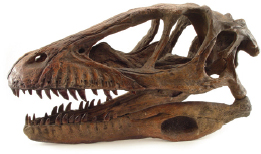EXAMPLE 5Solving a Differential Equation for Decay
The skull of an animal found in an archaeological dig contains about 20% of the original amount of carbon-14. If the half-life of carbon-14 is 5730 years, how long ago did the animal die?

Solution Let A=A(t) be the amount of carbon-14 present in the skull at time t. Then A satisfies the differential equation dAdt=kA, whose solution is A=A0ekt
where A0 is the amount of carbon-14 present at time t=0. To determine the constant k, we use the fact that when t=5730, half of the original amount A0 remains. 12A0=A0e5730k12=e5730k5730k=ln12=−ln2k=−ln25730
The relationship between the amount A of carbon-14 present and the time t is A(t)=A0e(−ln2/5730)t
In this skull, 20% of the original amount of carbon-14 remains, so A(t)=0.20A0. 0.20A0=A0e(−ln2/5730)t0.20=e(−ln2/5730)t
Now, we take the natural logarithm of both sides. ln0.20=−ln25730⋅tt=−5730⋅ln0.20ln2≈13,300
The animal died approximately 13,300 years ago.